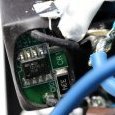Leaderboard
Popular Content
Showing content with the highest reputation on 11/13/19 in all areas
-
I know that feeling. There is always that one guy that has another little tweak 😂 Already seeing a 19% improvement in the memory score with this set. I'll also test hugepages. By using "interleave" you spread the RAM accross all memory controllers from all nodes, even the ones from the node you're maybe not using in the VM. On first gen TR4 this was a big issue, because it added a lot of RAM latency. Sure you get the higher memory bandwith by using "quad channel" but in most scenarios in my tests the lower latency was the preferred option. Not exactly sure how big of a difference it is on second gen TR4, but using "Preferred" or "Strict" was the better choice for me. Every program, game or benchmark is more or less affected by the lower bandwith by basically turning the RAM into a dual channel configuration. The bigger impact I saw by reducing the latency by using the "strict" setting. Maybe have a look into the "Cache & Memory Benchmark" which comes with AIDA64 to test this. This is a part of the extra CPU flags I use for a while now. <cpu mode='custom' match='exact' check='full'> <model fallback='forbid'>EPYC</model> <topology sockets='1' cores='7' threads='2'/> <cache level='3' mode='emulate'/> <feature policy='require' name='topoext'/> <feature policy='disable' name='monitor'/> <feature policy='require' name='hypervisor'/> <feature policy='disable' name='svm'/> <feature policy='disable' name='x2apic'/> </cpu> By forcing Windows into recognizing the CPU as an EPYC with these tweaks, it also recognizes the correct L1, L2 and L3 cache sizes which the node has to offer. Without it showed wrong cache sizes and wrong mapping numbers. Without these tweaks and the correct readings, starting up 3DMark for example always crashed or frooze the VM completly at the point, where it gathers the system infos. Not sure which other software might be affected, but this helped me in this scenario. Obvisiously the vcore is reported wrong, but the cache info is reported correctly with this tweak. 1 core is used for iothread and emulatorpin <emulatorpin cpuset='8,24'/> <iothreadpin iothread='1' cpuset='8,24'/> and the rest only specifically for this one VM. One 8 core die of the 2 from the 1950x is dedicated to this VM only and by adding up the numbers it exactly matches the specs of AMD. BUT this isn't the complete list of tweaks. There are way more you can play around with 😂😂😂 <cpu mode='custom' match='exact' check='full'> <model fallback='forbid'>EPYC-IBPB</model> <vendor>AMD</vendor> <topology sockets='1' cores='4' threads='2'/> <feature policy='require' name='tsc-deadline'/> <feature policy='require' name='tsc_adjust'/> <feature policy='require' name='arch-capabilities'/> <feature policy='require' name='cmp_legacy'/> <feature policy='require' name='perfctr_core'/> <feature policy='require' name='virt-ssbd'/> <feature policy='require' name='skip-l1dfl-vmentry'/> <feature policy='require' name='invtsc'/> </cpu> At some point I stopped, because I had no time back than to fiddle arround with it even further and the system was stable enough anyways. Main programs run fine and games performed great. Edit: Forgot to mention it reports "Hyperthreaded" for me in CoreInfo.2 points
-
Ussually mover is run by schedule but some times we run mover manually. When we run it manually it would be nice to know how long will take mover to copy all the files. I feel safe not working with files while mover is running. (sure is paranoia but I feel safe) Would it be possible to add some kind of % bar showing information about the mover process? At least I will know how long will it take. Thankyou Gus1 point
-
Working at the /mnt/diskX level WILL update parity appropriately as files/folders are moved around.1 point
-
I think that mistake is caused more by people not understanding the word "format", a word that everyone seems to think they understand, but really have no idea of what happens specifically. "Format" doesn't mean "get this disk ready to use (again)", whatever that might mean exactly. Format means "write an empty filesystem to this disk". That is what it has always meant in every operating system you have ever used. Unraid treats that write operation just as it does any other, by updating parity. So after formatting a disk in the parity array, parity agrees the disk has an empty filesystem, and rebuilding a formatted disk from parity will result in an empty filesystem.1 point
-
This is addressed in version 6.8. Passphrases are no longer stored in a keyfile.1 point
-
The basic architecture didn't really changed between first and second gen TR4. They only added 2 more nodes and improved the interconnection latencies of the first gen. The rest is basically the same. Inside the cputune tag. <vcpu placement='static'>14</vcpu> <iothreads>1</iothreads> <cputune> <vcpupin vcpu='0' cpuset='9'/> <vcpupin vcpu='1' cpuset='25'/> <vcpupin vcpu='2' cpuset='10'/> <vcpupin vcpu='3' cpuset='26'/> <vcpupin vcpu='4' cpuset='11'/> <vcpupin vcpu='5' cpuset='27'/> <vcpupin vcpu='6' cpuset='12'/> <vcpupin vcpu='7' cpuset='28'/> <vcpupin vcpu='8' cpuset='13'/> <vcpupin vcpu='9' cpuset='29'/> <vcpupin vcpu='10' cpuset='14'/> <vcpupin vcpu='11' cpuset='30'/> <vcpupin vcpu='12' cpuset='15'/> <vcpupin vcpu='13' cpuset='31'/> <emulatorpin cpuset='8,24'/> <iothreadpin iothread='1' cpuset='8,24'/> </cputune> <numatune> <memory mode='strict' nodeset='1'/> </numatune> <resource>1 point
-
The screenshot he showed you was from Settings - Unassigned Devices.1 point
-
Yes, just make sure you don't assigned old disk1 to parity slot, and don't check parity is already valid, only the disk assigned to the parity slot will be overwritten. Unraid will ask for a new passphrase but just enter old one.1 point
-
1 point
-
1 point
-
1 point
-
I found a domain feature which may enable hyperthreading in AMD CPU's that don't support it. <feature policy='require' name='topoext'/> I will experiment with it. Utilizing the following gave a 19% improvement in RAM scores with negligible differences between 1/32/1 & 1/62/2. VM had 12 GB of RAM assigned and this evenly spread it between the two numa nodes that had the memory attached to it - VM was likewise pinned to those nodes so the VM matched the physical. <numatune> <memory mode='interleave' nodeset='0,2'/> </numatune> <cpu mode='host-passthrough' check='none'> <topology sockets='1' cores='32' threads='1'/> <numa> <cell id='0' cpus='0-15' memory='6291456' unit='KiB'/> <cell id='1' cpus='16-31' memory='6291456' unit='KiB'/> </numa> </cpu>1 point
-
Weird still 800Mhz, likely hardware issue. Recently, Gigabyte have big change on their BIOS GUI (Intel) outlook.1 point
-
New Intel microcode for MOAR CVE: https://github.com/intel/Intel-Linux-Processor-Microcode-Data-Files/releases/tag/microcode-20191112 https://www.phoronix.com/scan.php?page=news_item&px=iITLB-Multihit-TAA-Kernel-Code1 point
-
Has it always been like this or has the problem only recently arisen? Is the CPU heatsink/fan working?1 point
-
Can you try installing windows and see if the CPU ramps up correctly?1 point
-
No, you need to go into the controller webUI and select that override option in the controller settings.1 point
-
Created a issue on github also nodejs changed something (backported a few functions), yesterday all my images where rebuilt because of minor fixes and since nodejs changed something and the developer of CSMM-7DtD not i can't get the docker to run.1 point
-
This guest blog by @spx404 of SPX Labs is all about setting up a remote VPN backup server with Unraid. Check it out and let us know what you think of this setup or let him know if you have any questions here in the comments! If you enjoy this content, be sure to subscribe to @spx404's youtube channel! Read the full blog here: https://unraid.net/blog/remote-vpn-unraid-backup-server1 point
-
1 point
-
Not just you... this docker has a very frequent update. The auto updater plugin is your friend in this case, set it and forget it.1 point
-
Here is a written guide from LevelOneTechs, just thought I should mention it here: https://forum.level1techs.com/t/zfs-on-unraid-lets-do-it-bonus-shadowcopy-setup-guide-project/148764 Complimentary videos are on the Gamers Nexus YouTube channel. Thank you so much for the answer! Thanks so much for your work and contribution! Also, I am really surprised that UnRAID is running on the latest kernel! I was really thinking that it would be on some old kernel since NAS/server distros tend to do so. Also, on the GUI side of things, there is some active development on integrating ZFS with Cockpit: https://forums.servethehome.com/index.php?threads/cockpit-zfs-manager-coming-in-november.25668/ Would running cockpit on UnRAID or integrating the ZFS-manager plugin into the OS itself be something that could be feasible?1 point
-
Just an FYI for this forum: It has been 16 days since I have had any corruption with Plex. That only happened with 6.6.7. With anything newer, it would corrupt in less than a day. 6.8.0-rc4 and rc5 have been rock stable with the changes that were made. I'm glad that I stuck with the testing, and was able to work so close with the Unraid team. 🙂1 point
-
Update the container first if it's not up to date, then update through the webui. If that fails, go to the first post and go to the link for updating using command line.1 point
-
The next thing to test is the USB stick itself. Shutdown your server and plug your USB stick into a PC and check/repair the file system on it. With Windows you can right click and choose Properties, then Tools and check/repair the device. With macOS you can use the Disk Utility.1 point
-
Well i finally found the settings, turns out its inside CPU settings, silly me. But i ran into another problem, IKVM only works during BIOS, on windows it shows black screen. Tried chrome, IPMIview, console redirection. IPMI view android, But all are the same. checked the firmware and it's already up to date, any thoughts? Edit : turns out i have to unplug the monitor! It's working now, thank goodness.1 point
-
To close the loop on this, I was missing something. I noticed there was a version showing for IGFX VBOIS in the BIOS but not GOP. I changed the video option ROM from Legacy to UEFI. Additionally, I changed the primary PCIE device from 'Auto' to 'On Board'. the i915 driver now loads and I can maintain video via ipmi. (Just in case someone else runs into the same issue)1 point
-
@Rick Sanchez - I just created a new Win10 VM for myself. I thought I was stuck at the same place. However, It's a super simple fix if it's the same issue. You need to connect to the VNC _REALLY FAST_ so you can catch the boot screen where it says "Press any button to boot into the CDROM...". It may take a couple of tries, but you'll see it if you have your VNC client ready to go as soon as you hit Start on the VM.1 point
-
I can confirm that Plex hardware transcoding continues to work with the above settings. Very happy with my setup now.1 point














